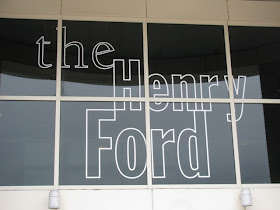We spent an entire day going through Greenfield Village, so we came back the next day for the inside part of the museum. Usually it has a complete history of transportation, but it's under construction, only 115 cars were on display. But again, this museum has lots of other stuff. Here are only a few examples.

 |
| Henry Ford's first horse-less carriage. He called it a quadricycle. |
 |
| These were some of the first passenger cars for trains. They literally took carriages and made them capable of rolling down the railroad tracks, attached behind an engine, circa 1831. |
 |
| This Model T is broken down into the pieces which were assembled on Henry Ford's moving assembly line. |
 |
| This is the actual plane Admiral Byrd used to fly over the south pole in 1926. |
 |
| Max, working as hard as he can, only lights 15 40-watt light bulbs. |
 |
| Whereas, I was lucky to light 5. The early steam engines could generate enough power to light 300, where today's power plants can power millions. |
 |
| This early steam powered pump was used in England in the late 1700s to pump out water from mine shafts. This is not a replica, but the real thing. |
 |
| The original 1957 Oscar Mayer Weiner Car. |
 |
| "Sweepstakes" was built in 1901 by Henry Ford and a few assistants. He drove this car to victory in the only race he was in. It also brought him the fame and financial backing to start his auto business and the founding of Ford Motor Company in 1903. |
 |
| It really would be fun to have a Model T. |
 |
| The Dymaxion House |
The Dymaxion House was the brainchild of a Wichita man, Buckmaster Fuller, who designed and built the house in 1929. Made of aluminum, it was completely portable, efficient, and made to be built on site. The idea never caught on and in the 1940s, investor William Graham bought the 2 prototypes and combined them into a single home, which his family did live in until the 1970s, although it was an extension to his regular home and never a stand alone as originally intended. He donated the home to The Henry Ford museum in the 1990s, where it is now on display.
 |
| Henry and Clara Ford, with son Edsel in 1929. |
 |
| A few miles away is the Henry Ford Estate. It was owned by the University of Michigan, Dearborn, but is in the process of being transferred to the Edsel and Eleanor Ford House. Donated to the University from the Ford Motor Company in 1957, it was open for tours until recently. It is now undergoing restoration and will be open again in 2013. But the grounds are open for people to enjoy. |
 |
| The 56 room residence on 1300 acres, named Fair Lane, was built in 1915 for a total cost of over $1 million dollars. It also included it's own power plant, making it a totally self-sufficient estate at the time it was built. |
 |
| It is still used for special events. I saw a window that I thought I might be able to see in. I couldn't. |
 |
| The back of the house faces the Rouge River. |
 |
| The garage, greenhouse and power plant. |


















No comments:
Post a Comment